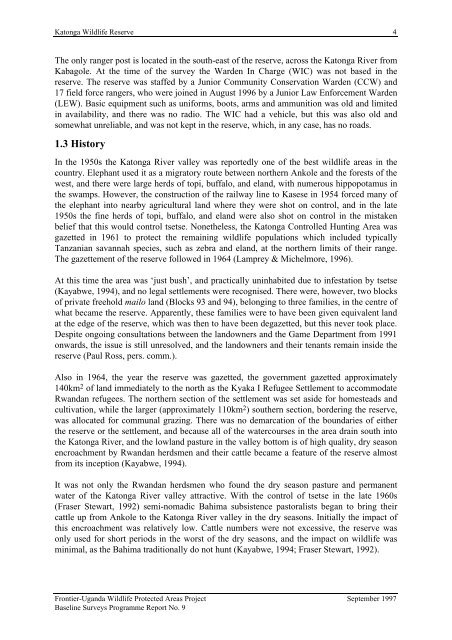Katonga Wildlife Reserve - Frontier-publications.co.uk
Katonga Wildlife Reserve - Frontier-publications.co.uk
Katonga Wildlife Reserve - Frontier-publications.co.uk
- No tags were found...
Create successful ePaper yourself
Turn your PDF publications into a flip-book with our unique Google optimized e-Paper software.
<strong>Katonga</strong> <strong>Wildlife</strong> <strong>Reserve</strong> 4The only ranger post is located in the south-east of the reserve, across the <strong>Katonga</strong> River fromKabagole. At the time of the survey the Warden In Charge (WIC) was not based in thereserve. The reserve was staffed by a Junior Community Conservation Warden (CCW) and17 field force rangers, who were joined in August 1996 by a Junior Law Enforcement Warden(LEW). Basic equipment such as uniforms, boots, arms and ammunition was old and limitedin availability, and there was no radio. The WIC had a vehicle, but this was also old andsomewhat unreliable, and was not kept in the reserve, which, in any case, has no roads.1.3 HistoryIn the 1950s the <strong>Katonga</strong> River valley was reportedly one of the best wildlife areas in the<strong>co</strong>untry. Elephant used it as a migratory route between northern Ankole and the forests of thewest, and there were large herds of topi, buffalo, and eland, with numerous hippopotamus inthe swamps. However, the <strong>co</strong>nstruction of the railway line to Kasese in 1954 forced many ofthe elephant into nearby agricultural land where they were shot on <strong>co</strong>ntrol, and in the late1950s the fine herds of topi, buffalo, and eland were also shot on <strong>co</strong>ntrol in the mistakenbelief that this would <strong>co</strong>ntrol tsetse. Nonetheless, the <strong>Katonga</strong> Controlled Hunting Area wasgazetted in 1961 to protect the remaining wildlife populations which included typicallyTanzanian savannah species, such as zebra and eland, at the northern limits of their range.The gazettement of the reserve followed in 1964 (Lamprey & Michelmore, 1996).At this time the area was ‘just bush’, and practically uninhabited due to infestation by tsetse(Kayabwe, 1994), and no legal settlements were re<strong>co</strong>gnised. There were, however, two blocksof private freehold mailo land (Blocks 93 and 94), belonging to three families, in the centre ofwhat became the reserve. Apparently, these families were to have been given equivalent landat the edge of the reserve, which was then to have been degazetted, but this never took place.Despite ongoing <strong>co</strong>nsultations between the landowners and the Game Department from 1991onwards, the issue is still unresolved, and the landowners and their tenants remain inside thereserve (Paul Ross, pers. <strong>co</strong>mm.).Also in 1964, the year the reserve was gazetted, the government gazetted approximately140km 2 of land immediately to the north as the Kyaka I Refugee Settlement to ac<strong>co</strong>mmodateRwandan refugees. The northern section of the settlement was set aside for homesteads andcultivation, while the larger (approximately 110km 2 ) southern section, bordering the reserve,was allocated for <strong>co</strong>mmunal grazing. There was no demarcation of the boundaries of eitherthe reserve or the settlement, and because all of the water<strong>co</strong>urses in the area drain south intothe <strong>Katonga</strong> River, and the lowland pasture in the valley bottom is of high quality, dry seasonencroachment by Rwandan herdsmen and their cattle became a feature of the reserve almostfrom its inception (Kayabwe, 1994).It was not only the Rwandan herdsmen who found the dry season pasture and permanentwater of the <strong>Katonga</strong> River valley attractive. With the <strong>co</strong>ntrol of tsetse in the late 1960s(Fraser Stewart, 1992) semi-nomadic Bahima subsistence pastoralists began to bring theircattle up from Ankole to the <strong>Katonga</strong> River valley in the dry seasons. Initially the impact ofthis encroachment was relatively low. Cattle numbers were not excessive, the reserve wasonly used for short periods in the worst of the dry seasons, and the impact on wildlife wasminimal, as the Bahima traditionally do not hunt (Kayabwe, 1994; Fraser Stewart, 1992).<strong>Frontier</strong>-Uganda <strong>Wildlife</strong> Protected Areas Project September 1997Baseline Surveys Programme Report No. 9
















